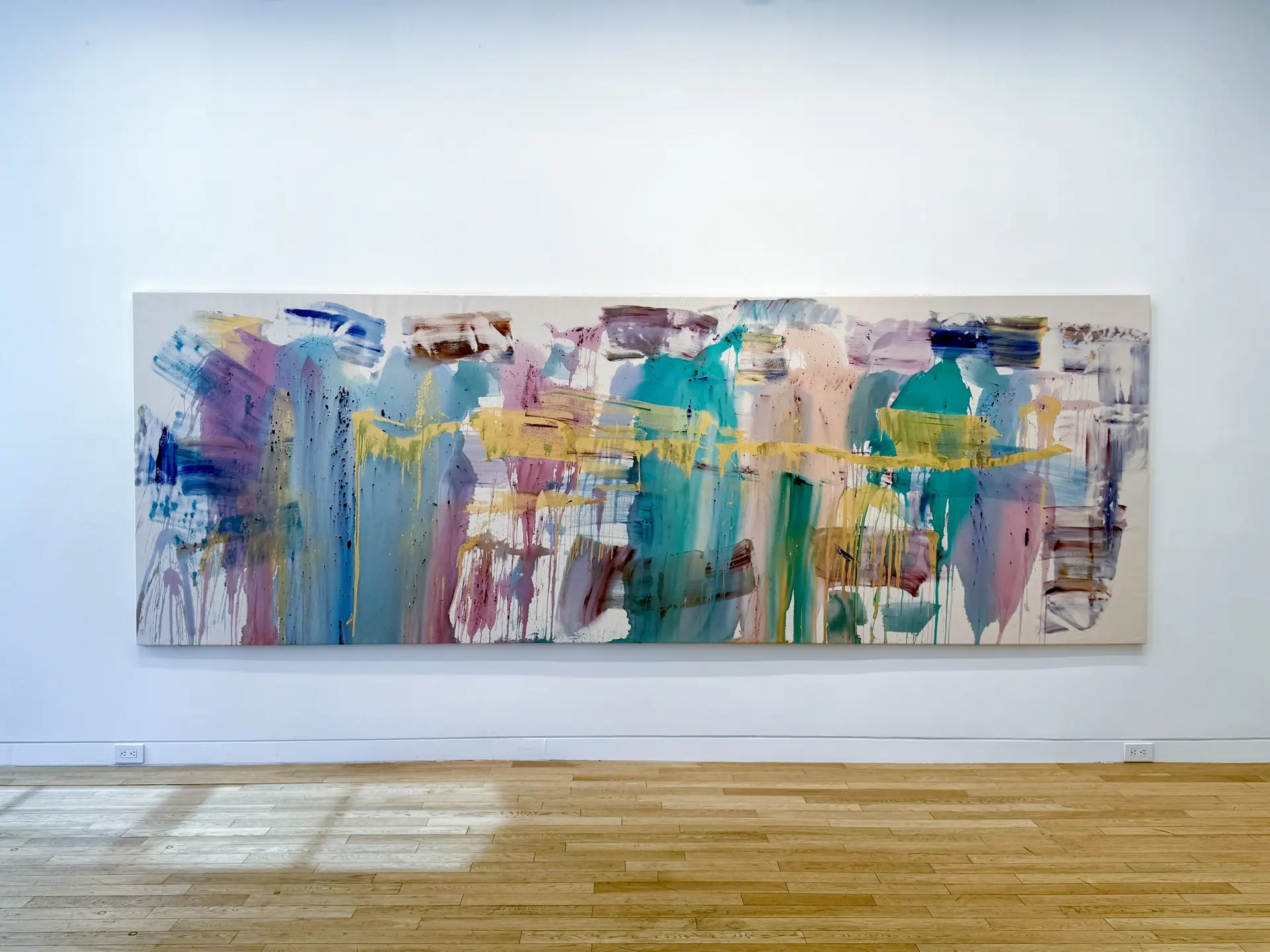
Installation view: Francine Tint: In Dialogue With Helen Frankenthaler, Upsilon Gallery, 2024. Courtesy Upsilon Gallery.
The eight paintings Francine Tint is showing at Upsilon represent a departure from those featured in her previous exhibition at the gallery last year. Pale tones, turbulent mark making, and collaged elements (themselves new to her work) figured prominently in the earlier show, while the paintings she’s completed this year are more economical, with open, expansive compositions, zones of raw canvas, and a generally warmer color palette. In his catalogue essay, art historian Robert S. Mattison notes that the precedents for Tint’s art come from Abstract Expressionism and Color Field painting. A small selection of works—two late prints and a mid-1980s painting on paper—by Helen Frankenthaler, whom Tint acknowledges as an influence, help illustrate Tint’s unique synthesis of the earlier movements.
While Frankenthaler often made pictorial allusions to landscape, as in the woodcut Japanese Maple (2005) included here, Tint’s paintings offer a more oblique engagement with the natural world. Color and light—or color as light, more specifically—are primary subjects of her work. In Airlift (2024), a painting remarkable for its clarity and lucidity, a streak of radiant orange, as bright as the raw canvas surrounding it, seems to materialize from the surface itself, casting its immersive glow upon the other colors in proximity. Airlift’s palette is like that of a sunset, with the stained colors pouring down the canvas separately. The radiant metallic stroke floating in the center of Golden Flutter (2024) seems also to emerge from within the canvas, like the flickering flame of a candle.

Francine Tint, Airlift, 2024. Acrylic on Canvas, 57 x 104 Inches. Courtesy the artist and Upsilon Gallery.
Staining is prominent among the techniques Tint employs in her work. While the first generation of Color Field painters like Morris Louis used the method to remove traces of the hand, Tint draws with the thinned pigment, using loose, sweeping gestures that recall those of the Abstract Expressionist artists. In contrast to the textured surfaces of a Hofmann or a de Kooning, the several campaigns of mark making in Tint’s painting accumulate in thin, interpenetrating layers. This is particularly effective in Heartbeat (2024), the show’s standout painting. The fourteen-foot-long canvas is loosely framed with a sequence of broad, architectonic marks that lead the eye in from the left, and at the bottom edge are woven through the translucent pours that span the painting. These marks help establish the graceful rhythm of the work, hovering weightlessly, suspended above the zones of flowing, blended color. Despite its monumental scale, Heartbeat feels airy and ethereal to the eye.
The last painting in the loose and open vein of Airlift and Heartbeat is Arete (2024), a vertical picture intermittently bisected by a ghostly white brushstroke. Unlike the other two works, Arete features an earth-toned palette, and is more densely painted. The few areas of unpainted canvas, found mostly around the edges, are utilized less as a framing device than as a color—the painting’s brightest, shining through the composition. Taken together, these three paintings indicate a new direction in Tint’s art, a rethinking and revitalization of the techniques that have long characterized her work. Though stained and layered, their colors are disembodied and transparent, often—especially in Airlift—seeming to float free of the canvas. Their effect on the viewer is gradual and immersive, unlike some of the artist’s more brashly colored and pressurized works.

Francine Tint, Arete, 2024. Acrylic on Canvas, 47 x 81 inches. Courtesy the artist and Upsilon Gallery.
Partly due to their large size and subtler colors, and partly because of how thoughtfully and spaciously the show was installed, the powerful presence of these three paintings seems to fill the gallery walls. Each painting has ample breathing room surrounding it, so that the viewer can take each one in slowly, on its own terms. Tint has never been wedded to a particular approach, and the pace of her experimentation has accelerated in the past five years or so. In her collaged works of 2022–23 she filled the surface with painterly drawing and texture. In these new canvases, she finds the surface, gradually and delicately, and the sensitivity of her process, evident in each painting, affords the viewer ample space for contemplation and meditation.
Alex Grimley is an art historian based in Philadelphia.



